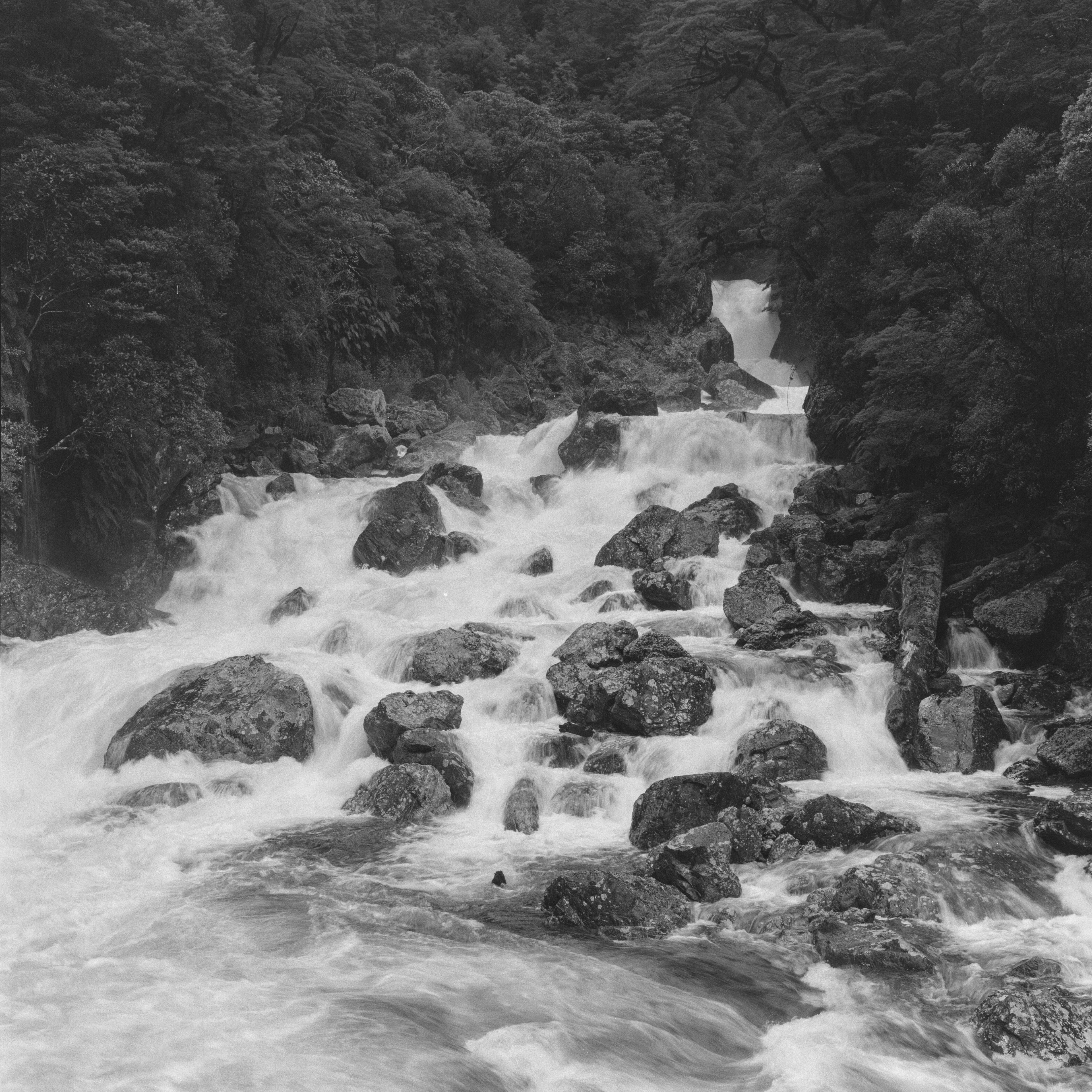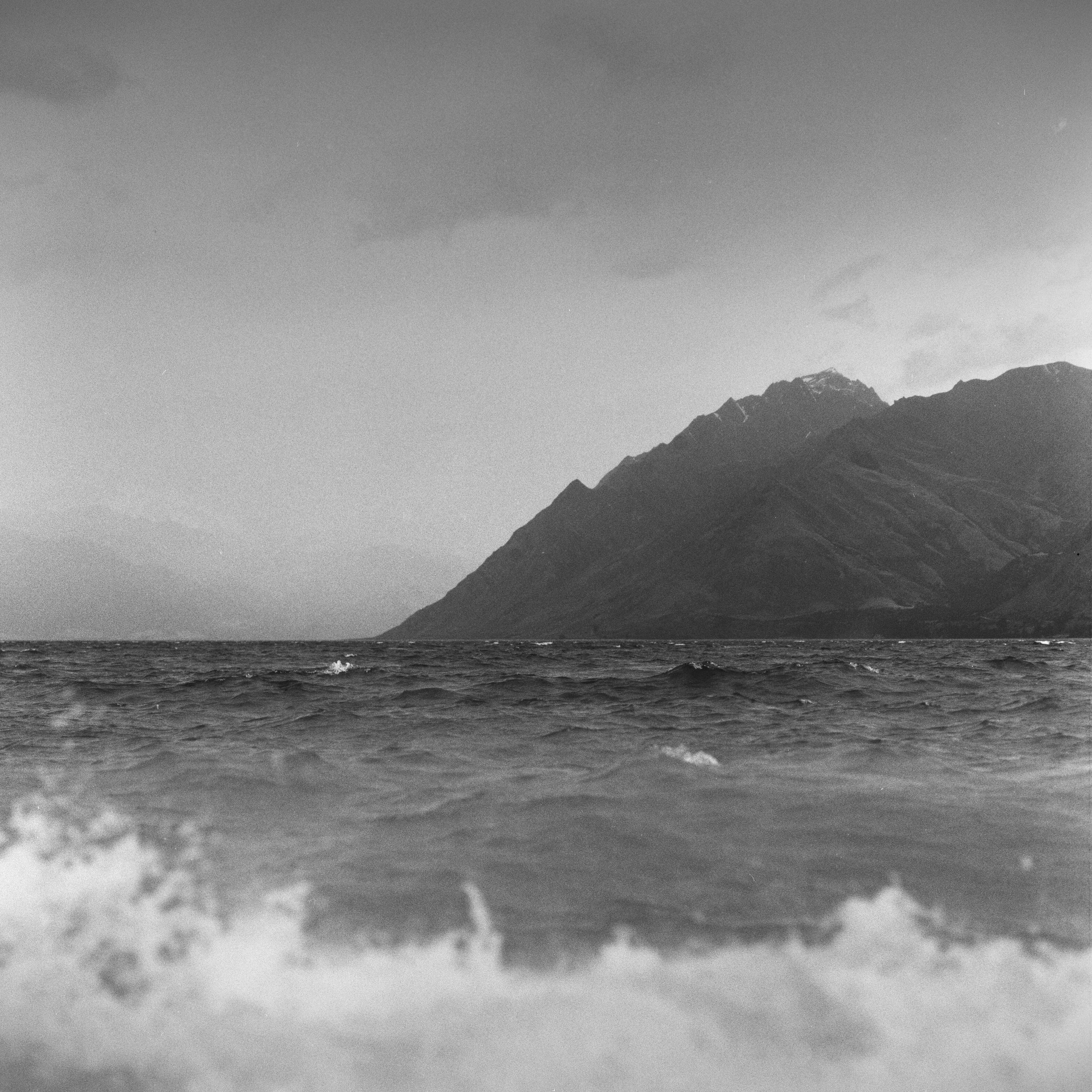
Hawea Storm.
We landed at Queenstown airport at the end of winter. It was M’s first time in New Zealand and I wanted to show her the landscapes that I had grown up around. We spent two weeks travelling around the southern lakes and mountains. In my bag was the Hasselblad 500cm film camera, a medium format camera system that produces images in a square 6cm x 6cm negative. Shooting in square is relatively new to me and this is my first major work doing so. I designed the trip to show M some of my favourite locations, and ensured we were at locations at the right time of day to line up with compositions and photographs I’d previsualised.
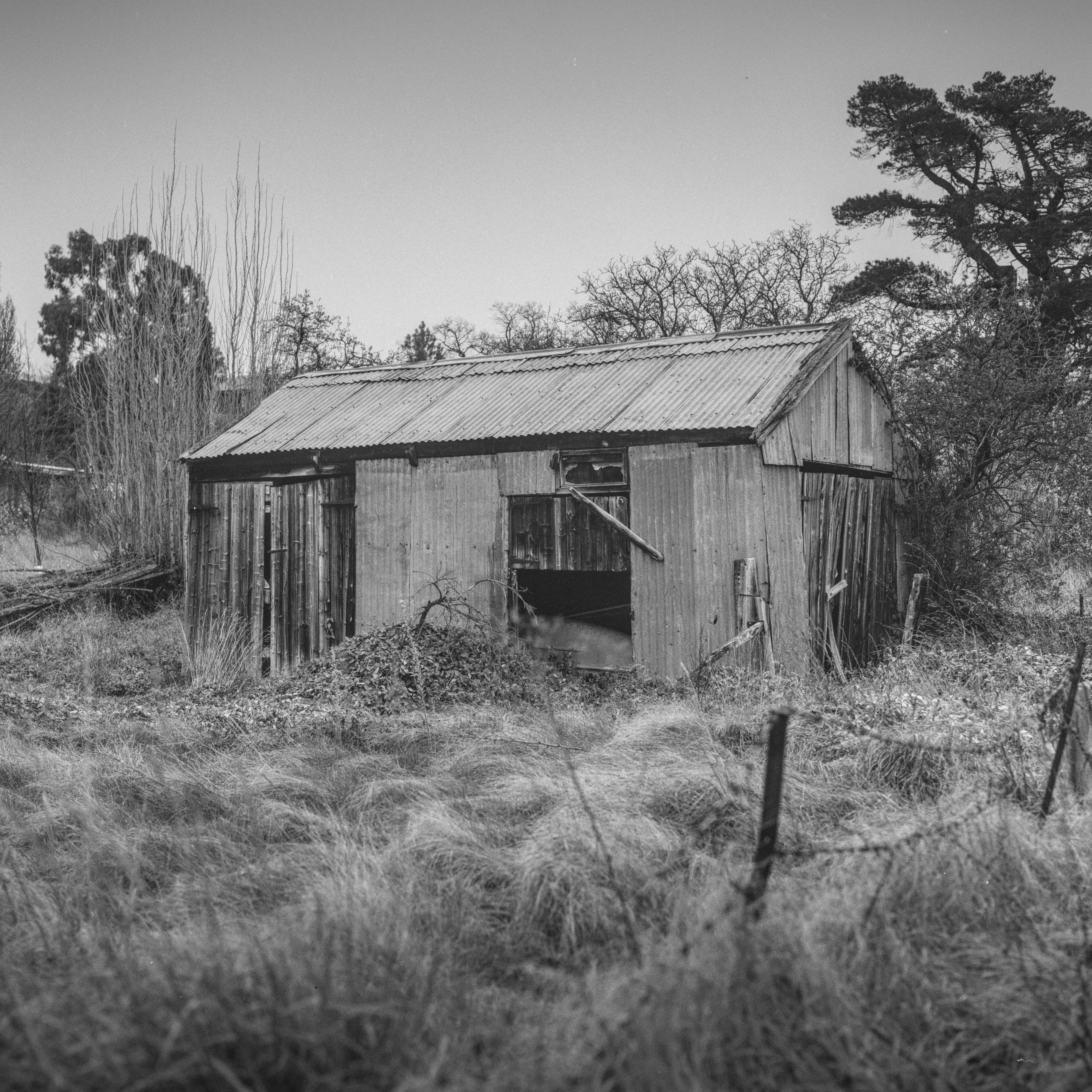
Bannockburn.
Our first destination was Wanaka to visit friends. Hawea was storming which made perfect conditions for the HP5+ black and white film and style of photography I wanted to do. The next day the weather improved and we drove up the Treble Cone ski road for some sight seeing. This was the first snow we saw in the trip and M was excited by it. She was yet to build survival instincts around the snow and immediately fell for the snow-stuffed-down-the-back-of-your-neck trick. We went to the cafeteria and chewed our way through chips, observing the Wanaka snow culture. Skiers trudged around the room in boots and shiny goggles, looking simultaneously drunk, hungover, energised, and exhausted. There was a certain cultishness about it, with the skiiers and snowboarders all thumping around the cafe in a similar style. Pynchon would write it as an extravagant hippy counter culture movement. The star sign of the individual determined the colour of the thermals they wore. Ski lifts come with complimentary weed – bongs for skiers and joints for snowboarders. Government agents trying to infiltrate the group dress as Antarctic explorers and share tales of Amundsen and Scott in an attempt to win credibility.
Equally Pynchon is a Wanaka restaurant located in the larger RSA-style dining room/event hall of the Wanaka District Club. On one side of the room is the pub – log fire place, pool table, and plenty of standing room to enjoy a fresh pint of Speights. It’s the sort of place where there’s usually a couple of games of darts being played at any point in the night. On the other side of the divider is the restaurant – canteen style kitchen and dining with a full view into the you immediately know it’s authentic kitchen and a friendly yell as a greeting when you walk in. No Wanaka highschoolers flipping frozen burgers here, instead a patriarchal chef in impeccable whites who looks like he just walked off the set of Iron Chef. Thai Taste Wanaka – endorsed.
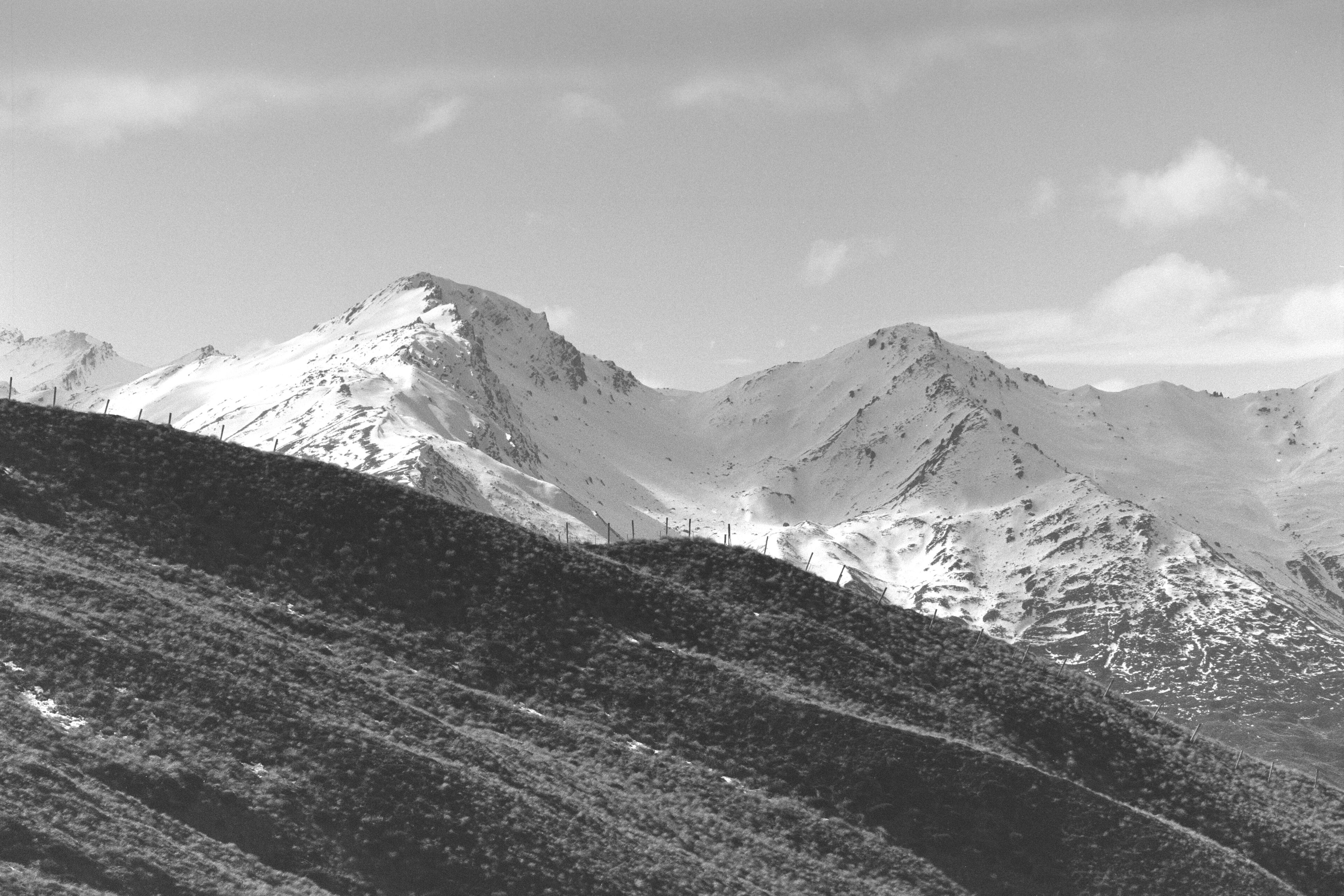
From Treble Cone.
Driving over the Lindis Pass the sun was shining and tussocks waved in the wind. We took a detour up the Ahuriri Valley until Zeus-the-thunderer visited shrouding the valley with cloud and rough showers.
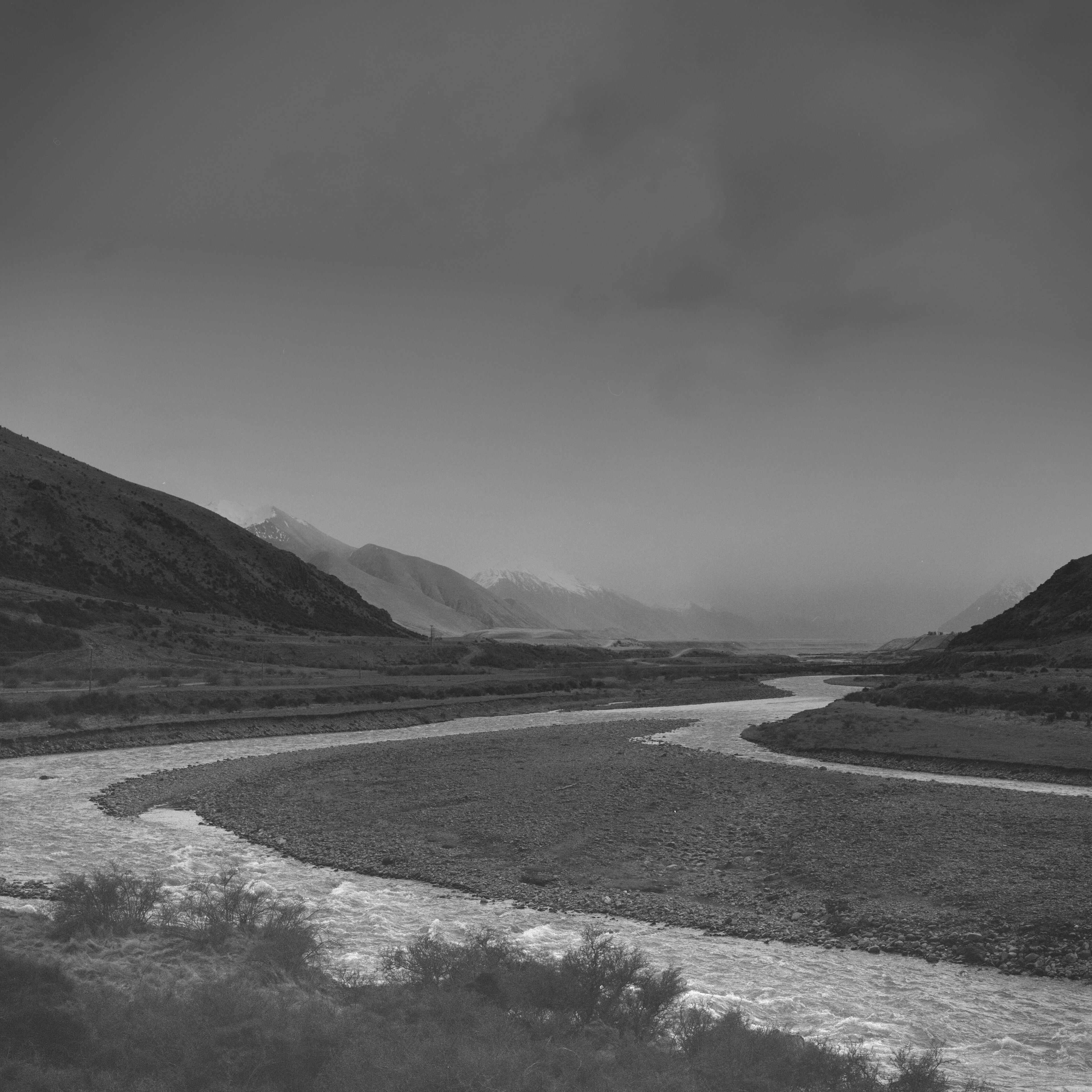
Ahuriri.
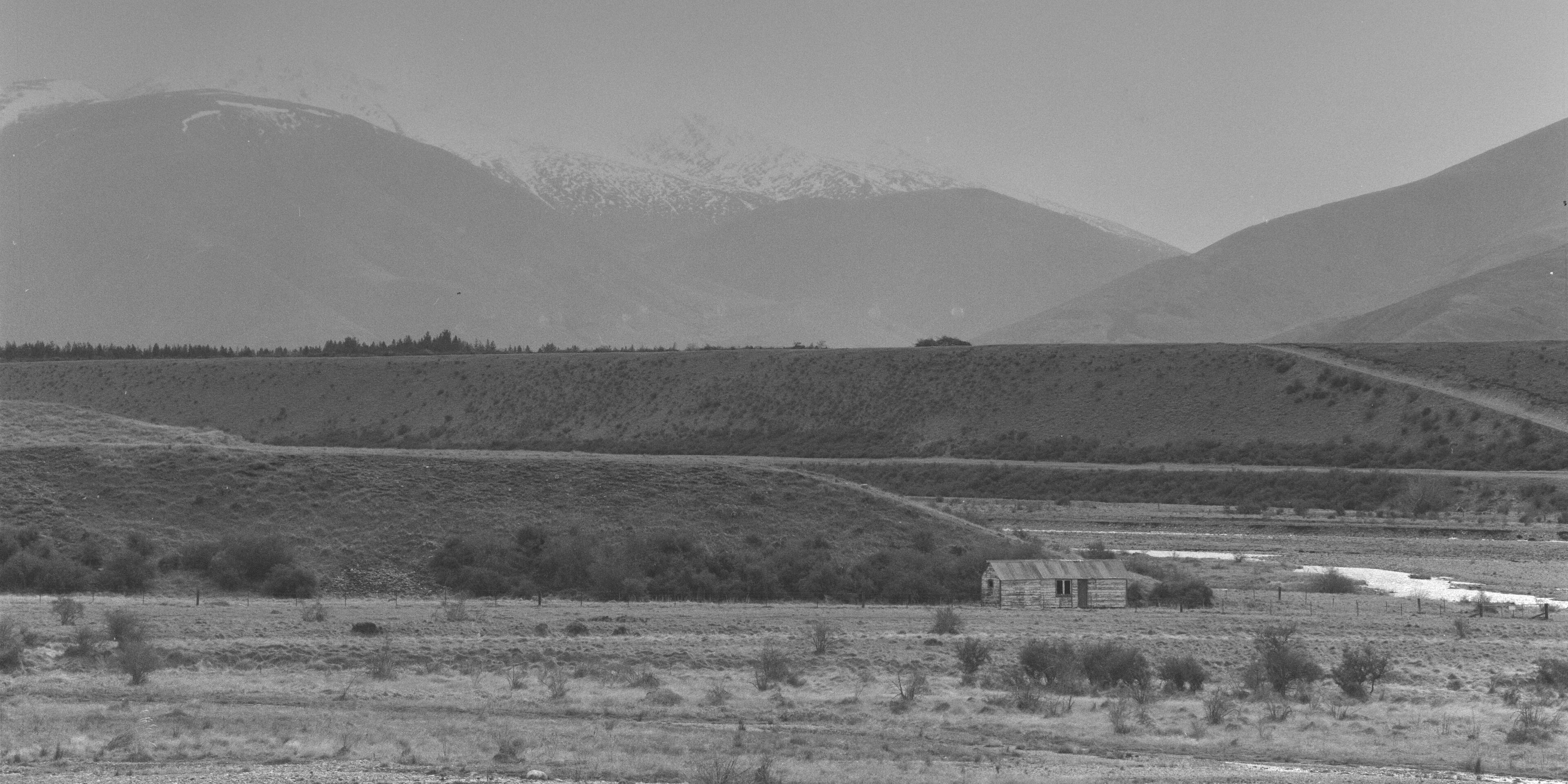
Ahuriri II.
A tactical retreat to Omarama for a mince pie and coffee where again the sun was shining. A slight breeze, but no sign of the storm. Of all of the landscapes we visited those around Twizel and Omarama resonated with me the most. They’re a more open and generous continuation of the Lindis and Ahuriri valleys. Tussock and farmland stretch for kilometres but still terminate at the foot of ranges which stand impressively on the horizon.
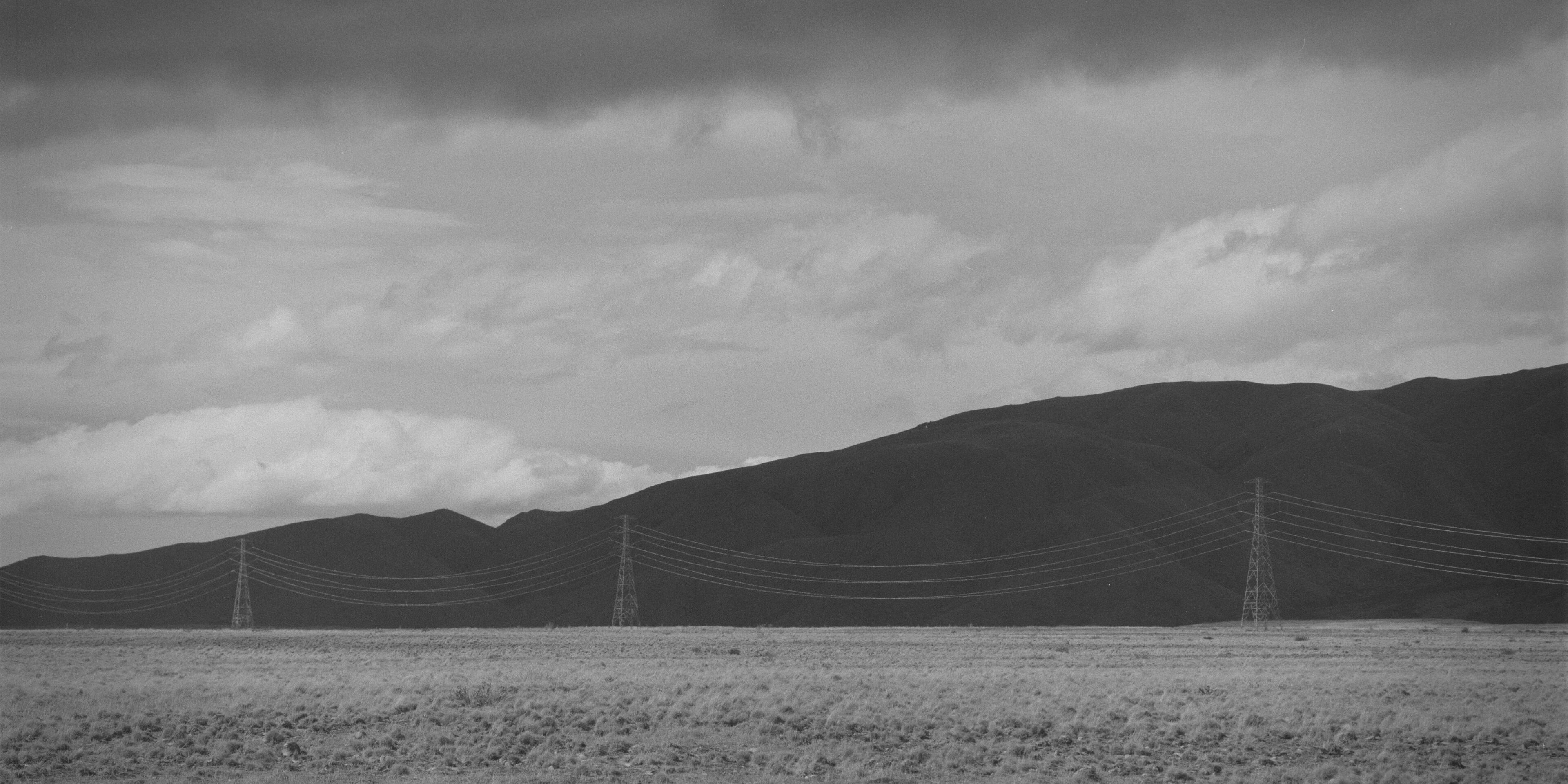
Near Omarama.
That afternoon we headed up the west side of Lake Ohau and the stormy conditions returned. Ohau Village was in the thick of it and, like the Ahuriri, the head of the lake was obscured by rain. The lake was trying to escape and the wind whipped water high to combine with the rain. Standing on the shore you felt droplets of water being flung at you from multiple angles. To the eye it was a monochromatic scene which is why I think the photographs came out so strong. I’ve shot in these conditions on digital and feel that the result comes out looking too clinical
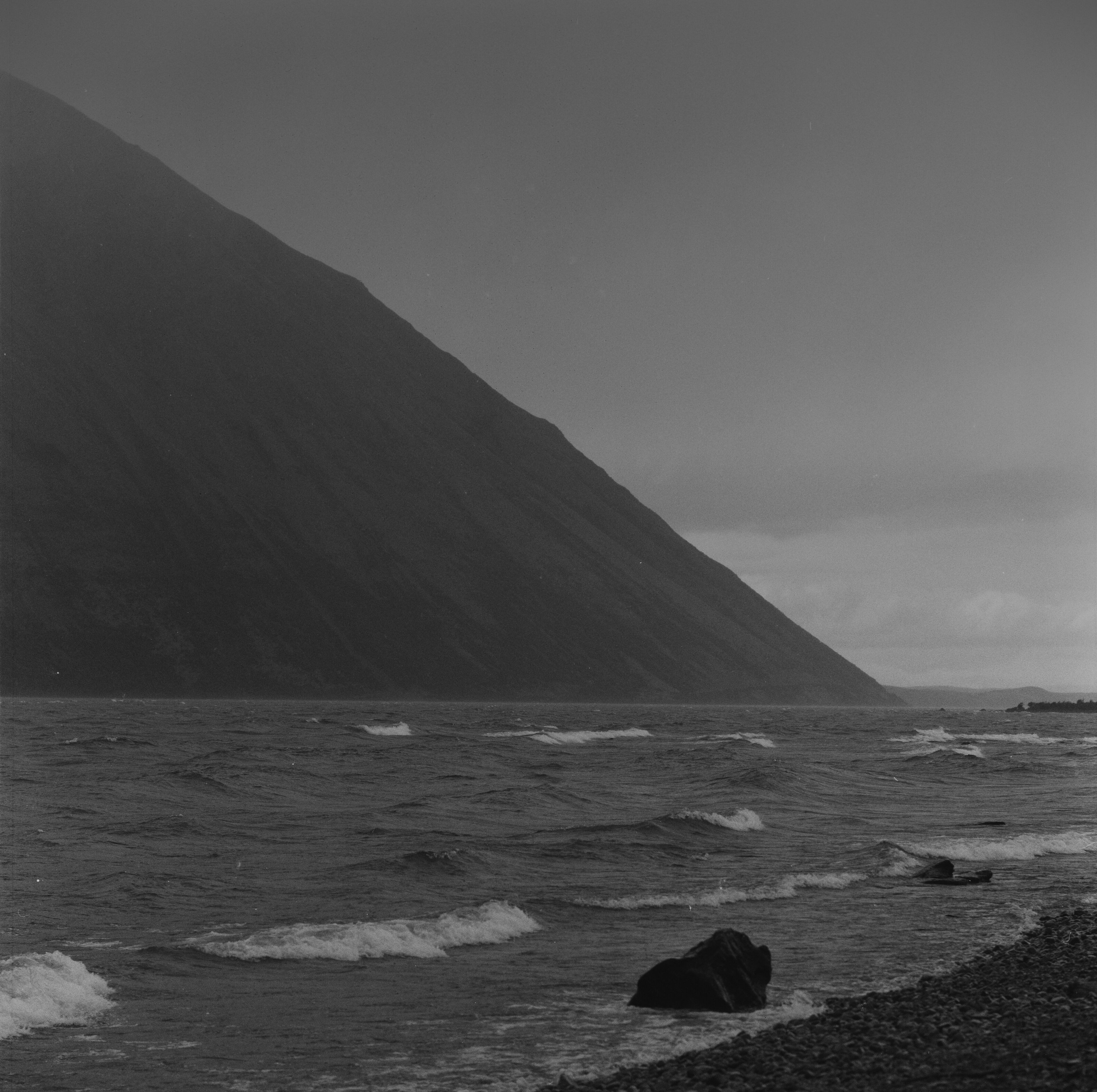
Ben Ohau in storm.
The rain applied a gray cellophane to the landscape leaving the form of Ben Ohau to dominate. When framed against the flat landscape looking over Twizel it looks out of place. The angle the mountain makes with the land fools one’s sense of scale in person and on film. I think square format compositions preserve the scale of the mountain – your eye isn’t drawn left or right like a 3:2 or panoramic image would. These are shot with the Hasselblad 80mm lens (equivalent to ~40mm on a full-frame camera).
The next day we returned to Lake Ohau, this time at the south-east corner of the lake close the outlet. Ben Ohau was backlit, and in the background the fresh snow on the Barrier Range was sparkling in the sun.
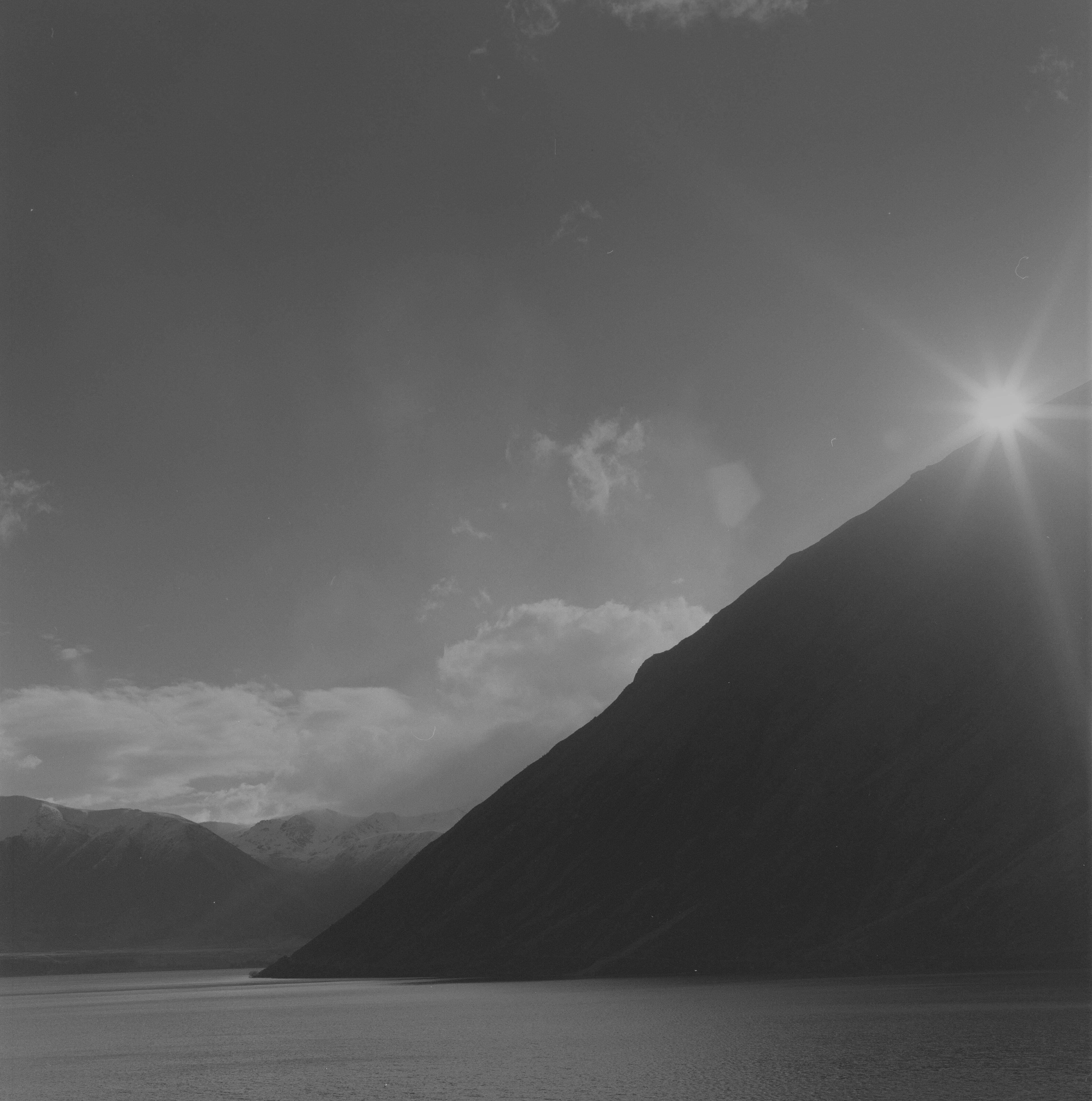
Ben Ohau shot from the opposite side in calmer weather.
In years past I favoured shooting wide and open landscapes (see the archive) – the more features, depth, and detail the better. On this trip I found myself shooting tighter scenes such as the forms of mountain peaks and ridges. Perhaps this was because I was shooting square format, where a wide shot means including more sky and foreground elements. I had a wide angled lens with me but barely used it. For shots that are clearly panoramic I happily shot them and cropped in post.
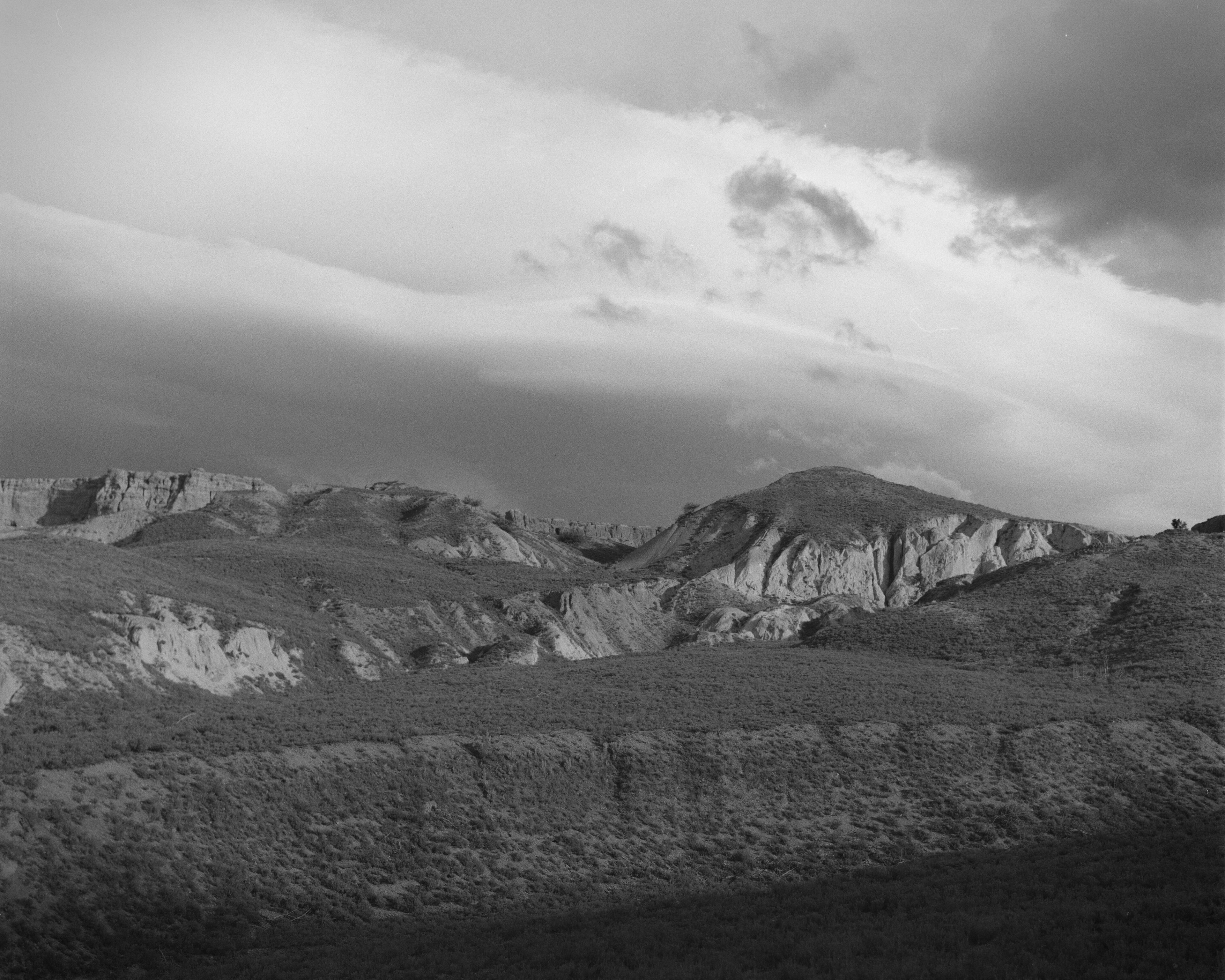
Bannockburn II.
Like Twizel, I think of Bannockburn and wider Cromwell area as an underrated spot. Easy to access, lots of landscapes, and far enough away from the main tourism drawcards. In planning for the trip I wanted to take M. to the Mt Difficulty cellar door. Timing took us there on a gray and rainy day which rather killed the romantic vision of a glass of pinot noir in the sunset.
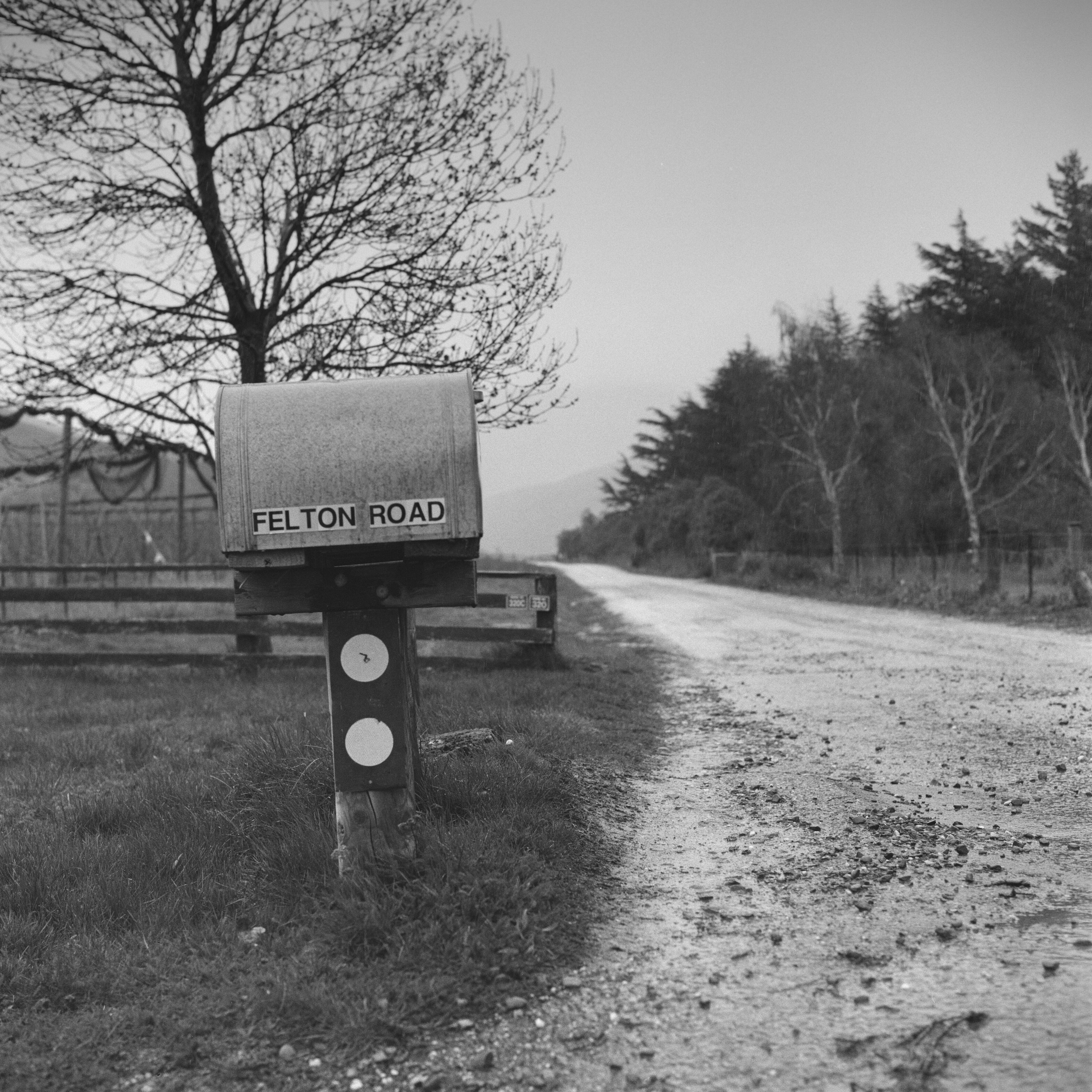
Felton Rd.
Friday we awoke to no power. The semiconscious confusion that usually comes when waking from a new bed while travelling was amplified. Not only did the light switches not work, I didn’t know where the bloody switches were. Snow and stormy weather overnight caused a power outages in parts of Central Otago. Under cover of darkness we assembled the gear and bundled into the car to warm up.
Over the last couple of years I’ve been enjoying and learning from Graham Sydney’s paintings. His technique, subjects, and moods he creates in his work inspires and challenges me in the way I shoot landscapes. I wanted to show M. Ida Valley, the Hawkdun Range, and some of the wide-open scenes that she’s seen in Sydney’s work. That snowy day we were due to drive to Dunedin. The plan was to leave early and spend the day in the Maniototo. By the time we got to Clyde heavy snow had set in and the road up the Manitoto was closed.
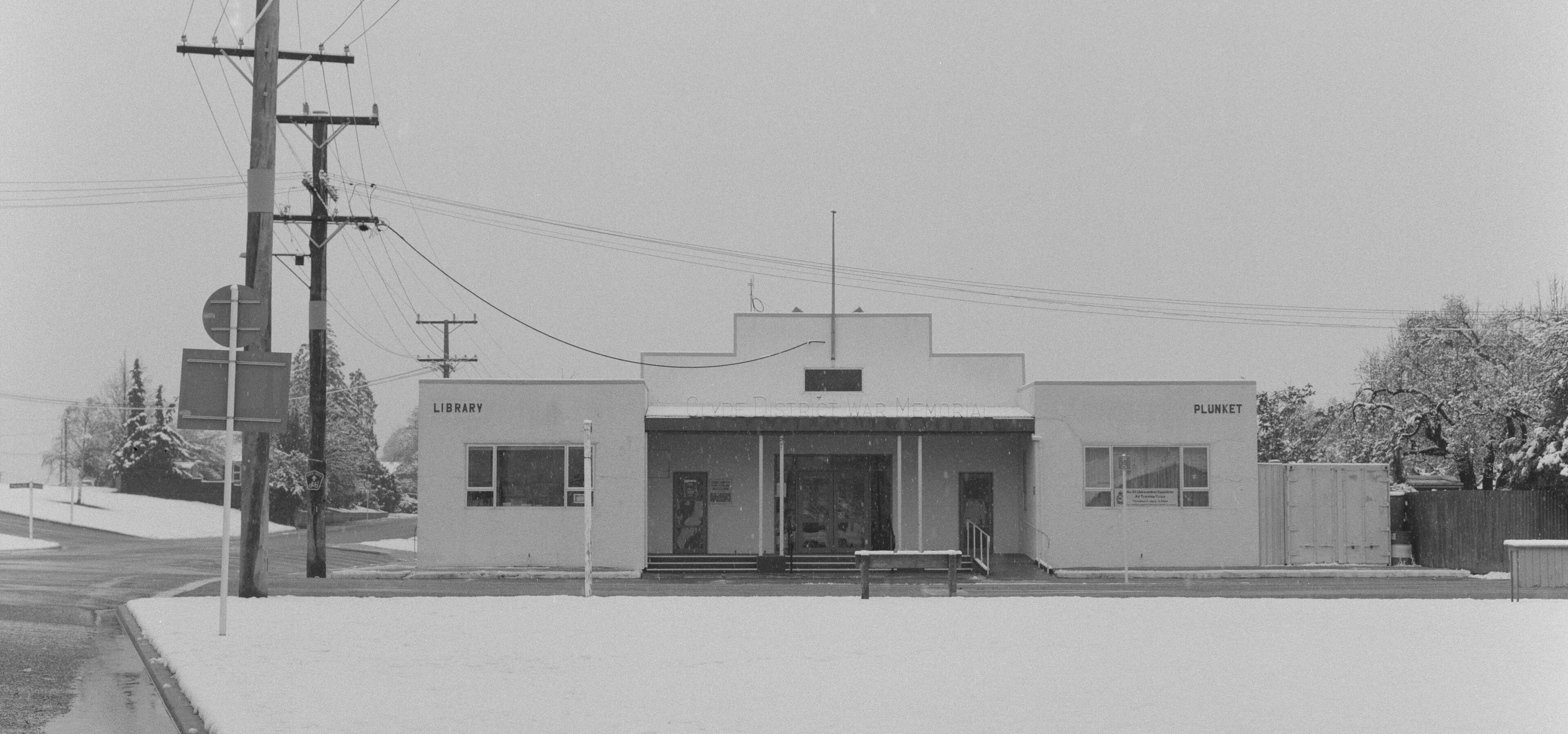
Clyde.

Roxburgh.
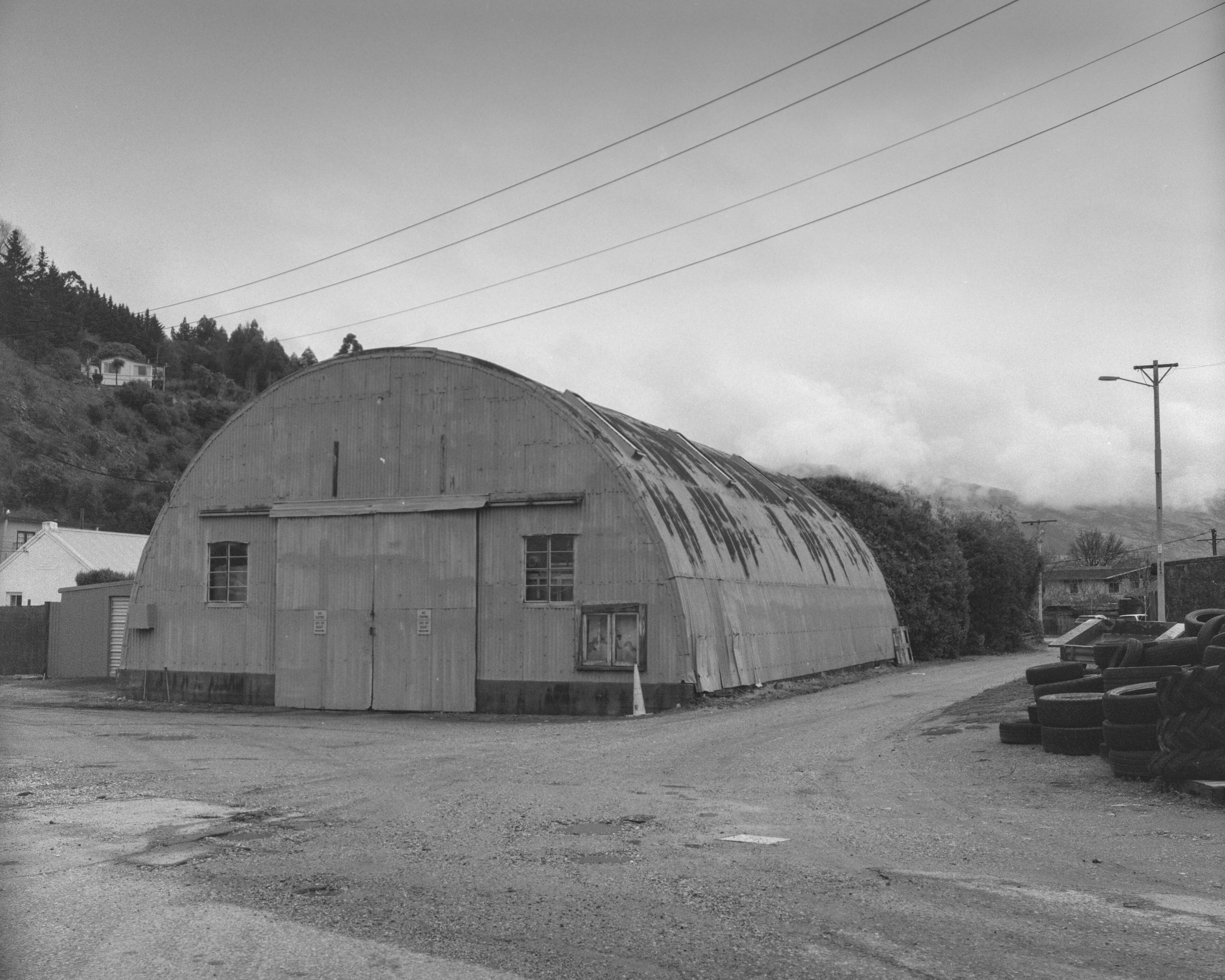
Roxburgh II.
The Hasselblad camera has a detachable film back allowing the shooter to load multiple backs with different types of film. Throughout the trip I had one loaded with HP5+ black and white, and one loaded with the colour Porta 400 film. I shot to the conditions, and ended up with twice the number of black and white images than I did colour. Just as well, as when I got the images developed I discovered a light leak in the film back that held the Portra. See a few of them here.
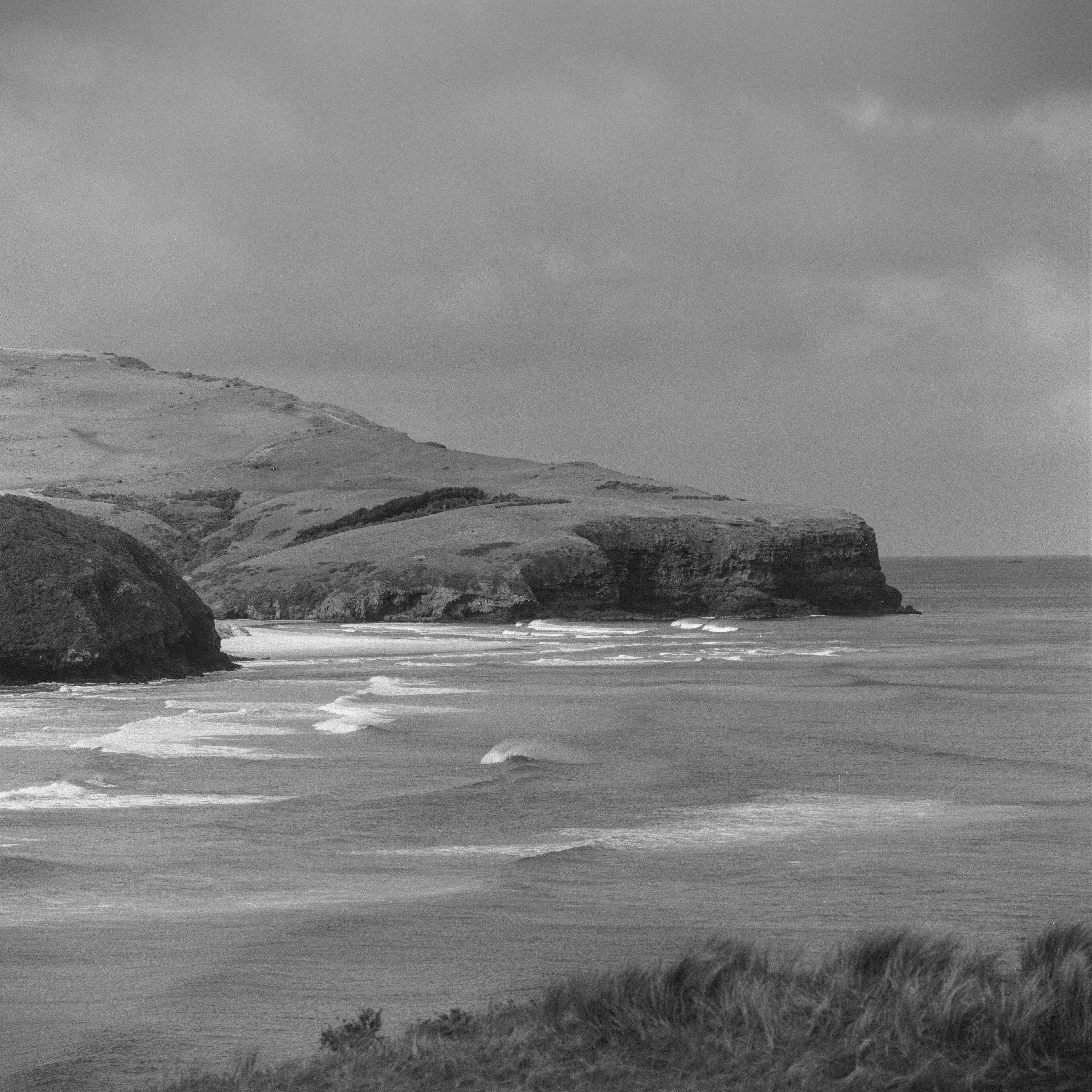
Dunedin -- Maori Head.
A southerly brought more snow on the drive from Dunedin to Te Anau. Spring was here, and when passing through towns flying cherry blossom often danced with falling snow. The shot below was taken at Mandeville.
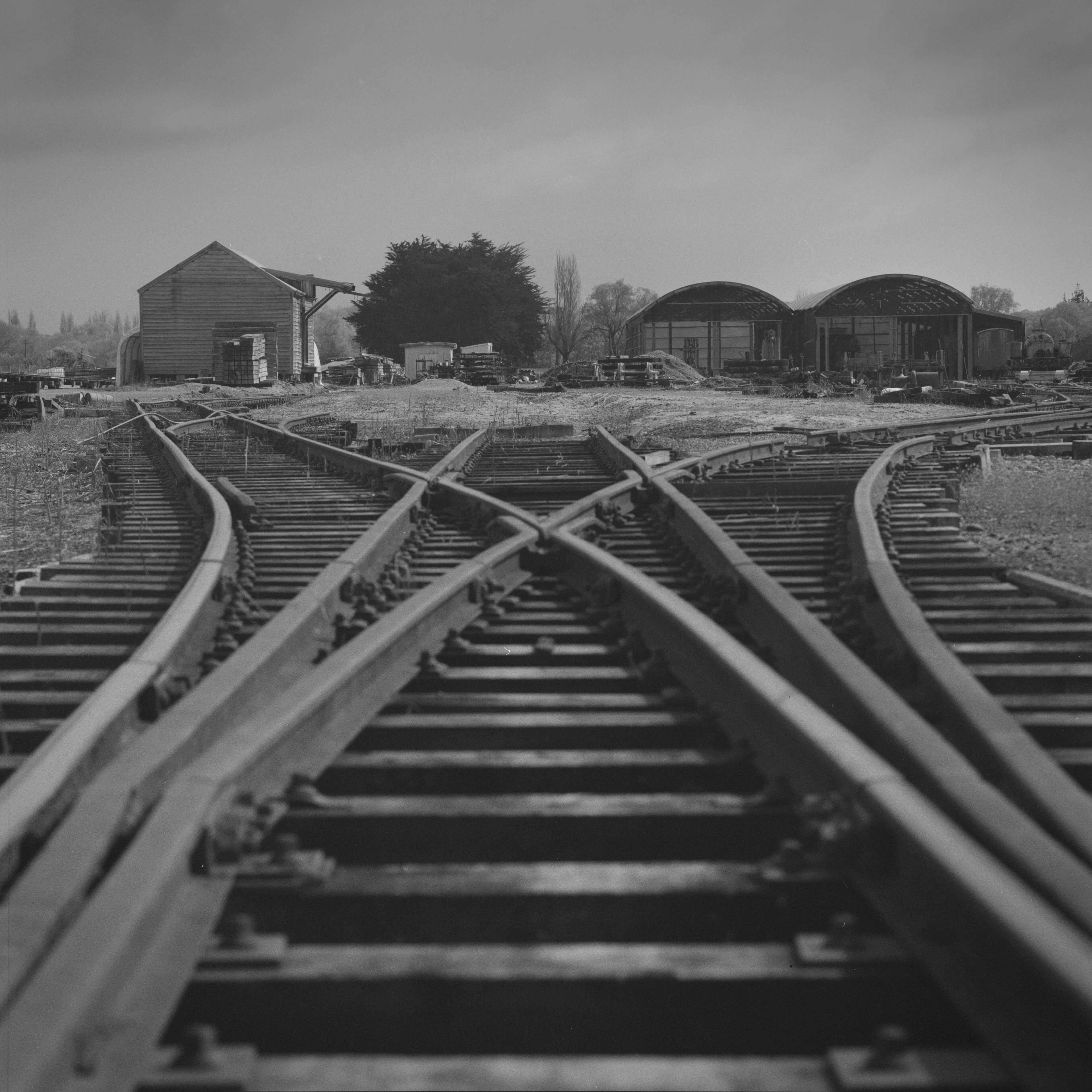
Waimea Plains.
On my commute to work on the Melbourne Metro train I’ve thought about this style of shot – putting the camera on the tracks and creating an leading lines into the frame that one can’t ignore. Some older stations like Auburn and Glenferrie still have sodium vapour lamps and during the evening blue hour there’s the complementary match of orange glowing light and train line. The shot would be perfect. Problem being the gigantic thundering trains that hurtle along Melbourne Metro lines.
Mandeville had no such problems, the lines go nowhere and on that rainy weekday the place was deserted. This shot relies on two features of the Hasselblad camera – the waist-level viewfinder and the square format of the image. The waist-level view finder allowed me to put the camera very low on the tracks and to get the alignment I needed to create the strong leading line into the frame. Square images benefit from the symmetry. I took a few images of this style with the rail line as foreground. This one worked because of the symmetric image giving way to an interesting and varied background. Shots that had just a single rail track didn’t work as your eye raced through the whole image bottom to top.
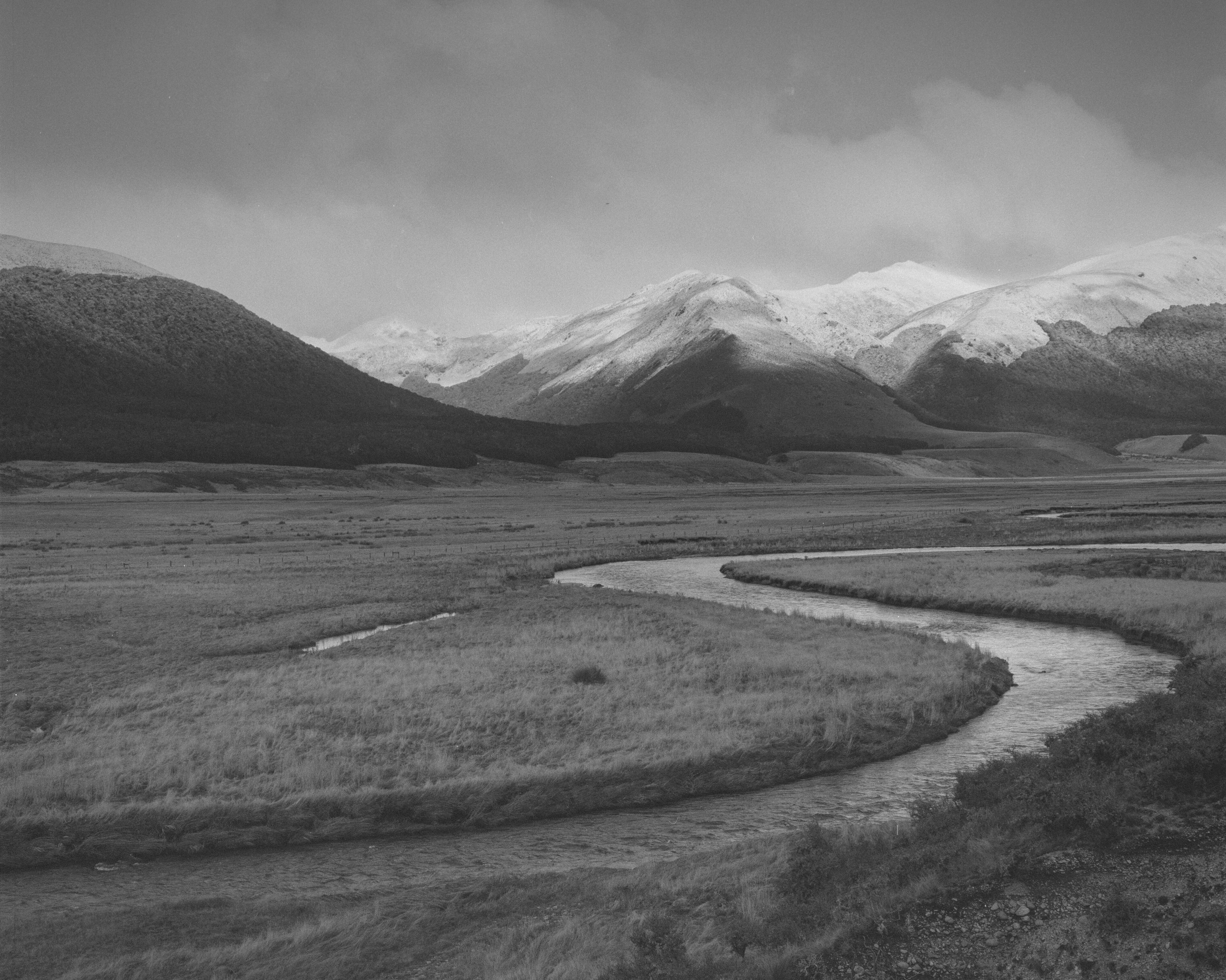
Near Mavora.
The Mavora Lakes sit wedged between mountain ranges. Narrow, pebbled beaches stretch along the lake front keeping back the ever-growing beech and fern forests. It’s the type of forest you’d find a hobbit or ent in, and is easily walkable save for the rotted log or holes in the ground from uprooted trees. The bush climbs the mountain slopes, growing in height until the green trees are topped with snow. Further up is the tussock line, though very little was visible when we visited, replaced instead by a blanket of snow.
This was my third visit to Mavora and every time I’ve been there my interpretation of the landscape has changed. The first time was in 2016 on a solo trip and I was drawn there on a whim to visit a film location for Lord of the Rings – where Frodo and Sam leave the fellowship who are busy fighting orcs, and set of in a little boat on the lake. I was floored by the beautiful landscape so free of people, and ended up spending a couple of days around the area. One day was walking up the eastern side of the north lake. Past the hobbit’s beach, through ancient beech, and then out and up onto the tussocks. Another day was south from the southern lake, on a mossed-over path straight out of a medieval fantasy novel – old tree trunks, moss, and mushrooms sprouted everywhere making it a memorable walk. I had just started getting into photography as a hobby and at the time believed that as a ‘real landscape photographer’ I should be shooting with the widest angle lens possible. I got a 14mm lens for my APS-C camera, which was great for the astro photography I was doing at the time. Still, I’m happy with my photographs of Mavora despite the wide angle lens removing all sense of scale from the mountains.
On this trip M and I were long on snow and short on time so we favoured driving over walking to see more of the landscape. The gravel road is slow going and there’s much more to see past the Mavora turnoff, following the Oreti River further north. Fences, shelter belts, and mounds of hay stood humble along the road set against the grander landscape behind them.

Mavora Lakes Road.
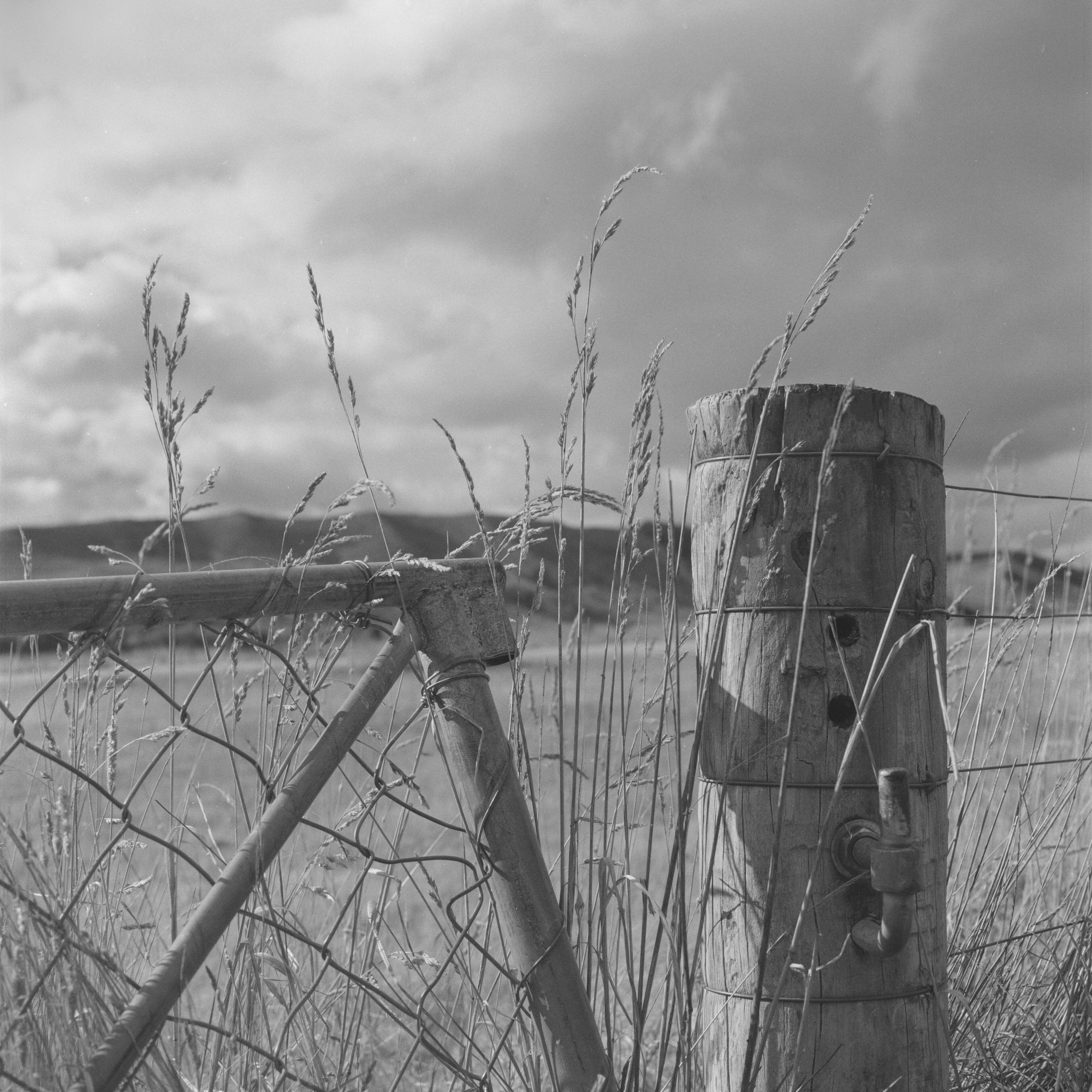
Mavora Lakes Road II.
Milford Road closed for snow. Expected to open 10am. While based in Te Anau, the plan was to take a day trip to Milford Sound and stop along the road for walks and photography. Mainland side of The Divide had light rain which was enjoyable enough to stroll around in and the clouds visible around the peaks made for some moody black and white shots. Once over The Divide we found that every ridge, rock, and tree branch had a thick coating of snow. The keas were out and about, and were hopping around the familiar car parks looking for new car parts to chew. Through the Homer Tunnel and snow was much heavier. A fingers-crossed drive took us back to sensible altitudes and by the time we reached sea level it looked like just another gray and rainy day. No visibility at the Milford Sound beach, a heavy rain, and car parks full of tourists all running to catch the cruise boat put me in a mood not to explore and get the fuck out of there. A couple of low effort photographs later and we were headed back to Te Anau where the intermittent showers gave us impetus to walk along the lake front.
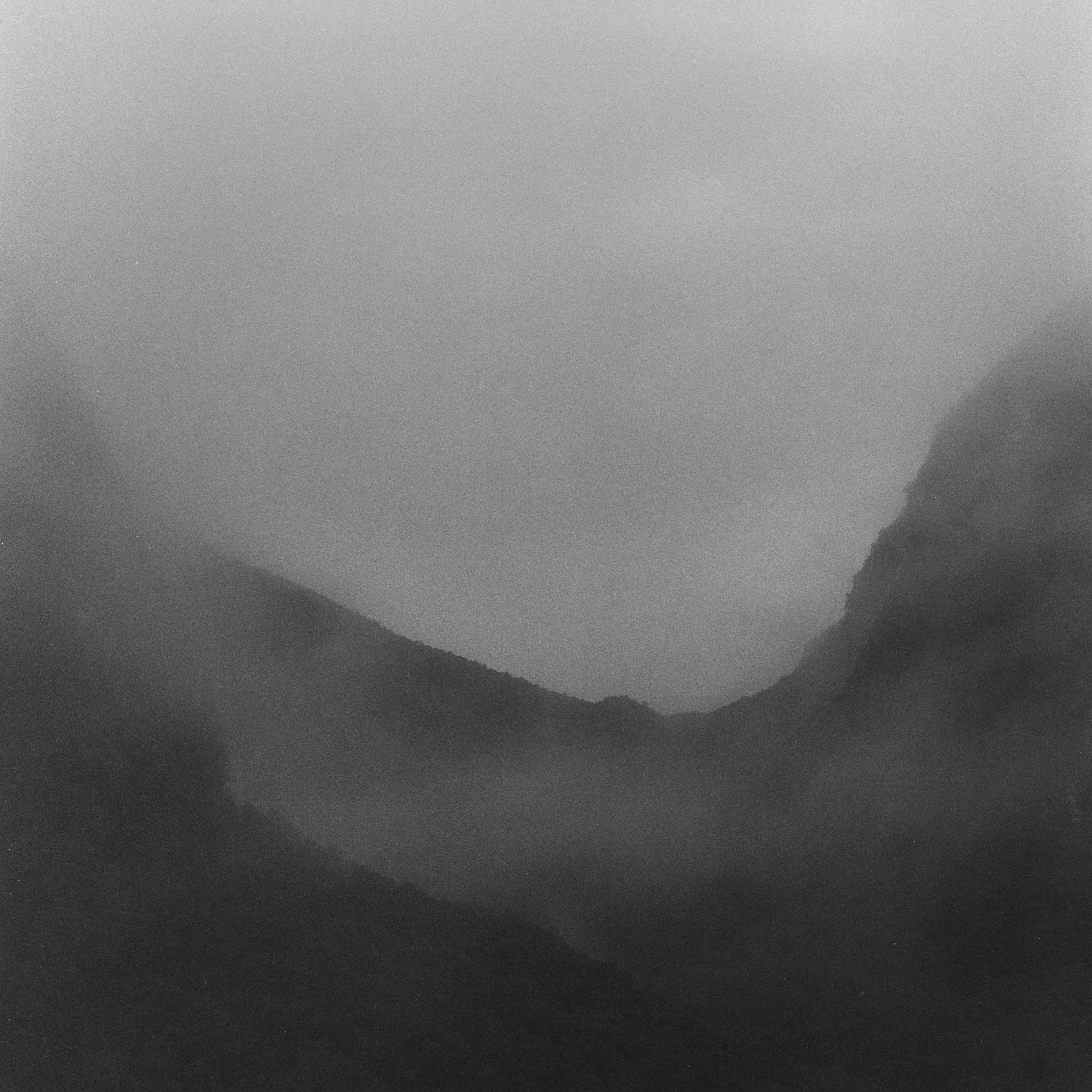
From The Divide.
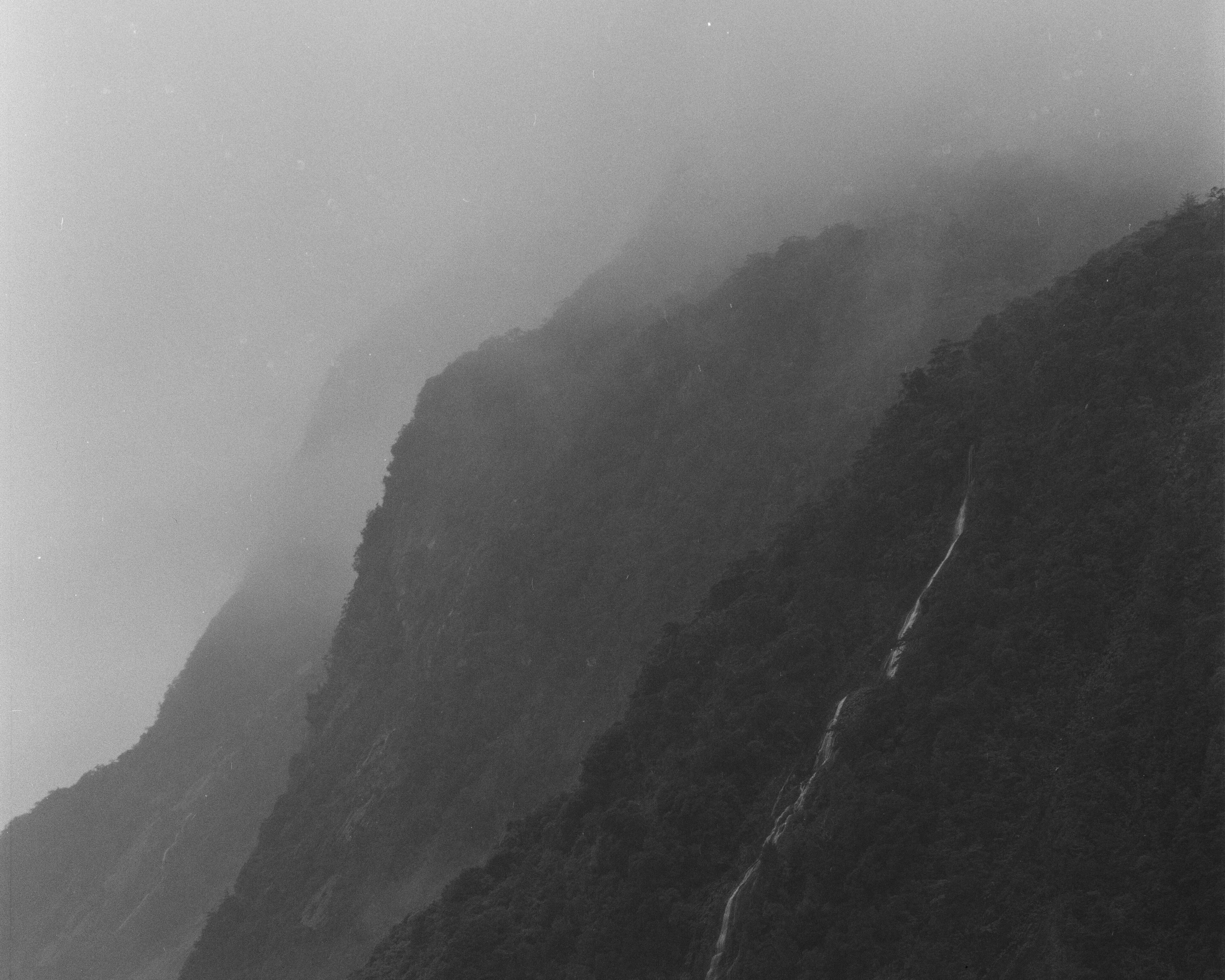
Milford Sound.
The highlight of the trip was a night on boat in Doubtful Sound. Of the fourty people or so aboard, half were part of a golden oldies tour. The lounge echoed in saccharine “oh really?”’s, advice that no one asked for, and an admirable will to drink the boat dry of all grog. Exclamations at the impressive nature we were in was seconded only by “say that again dear”. Any projected resentment must be understood in the context of self realisation. This group was balanced by four Europeans – Austrian perhaps? They looked and sounded German, but had a sense of humour. As soon as the boat pulled away from Manapouri harbour they reached into their backpacks and started pulling out bottles of corona. One magicked a bottle of blue curacao out of their rain jacket, and soon they were necking long necked bottles of green fizzing liquid. That was just the beginning. The party picked up in Doubtful Sound with the smell of weed following them around and by 8pm they’d started to make animal noises and by the end of the night were trying to start a rave with the geriatrics. The mood at breakfast was decidedly hungover which suited the somberness and peace that is there at sunrise in Doubtful Sound.
The weather in Doubtful could not have been better. Rain, breaking occasionally, with not too much wind to throw the water everywhere. The ephemeral waterfalls were in full flow and you could spent minutes tracing the branches and tributaries of the falls hundreds of metres up the cliff faces.
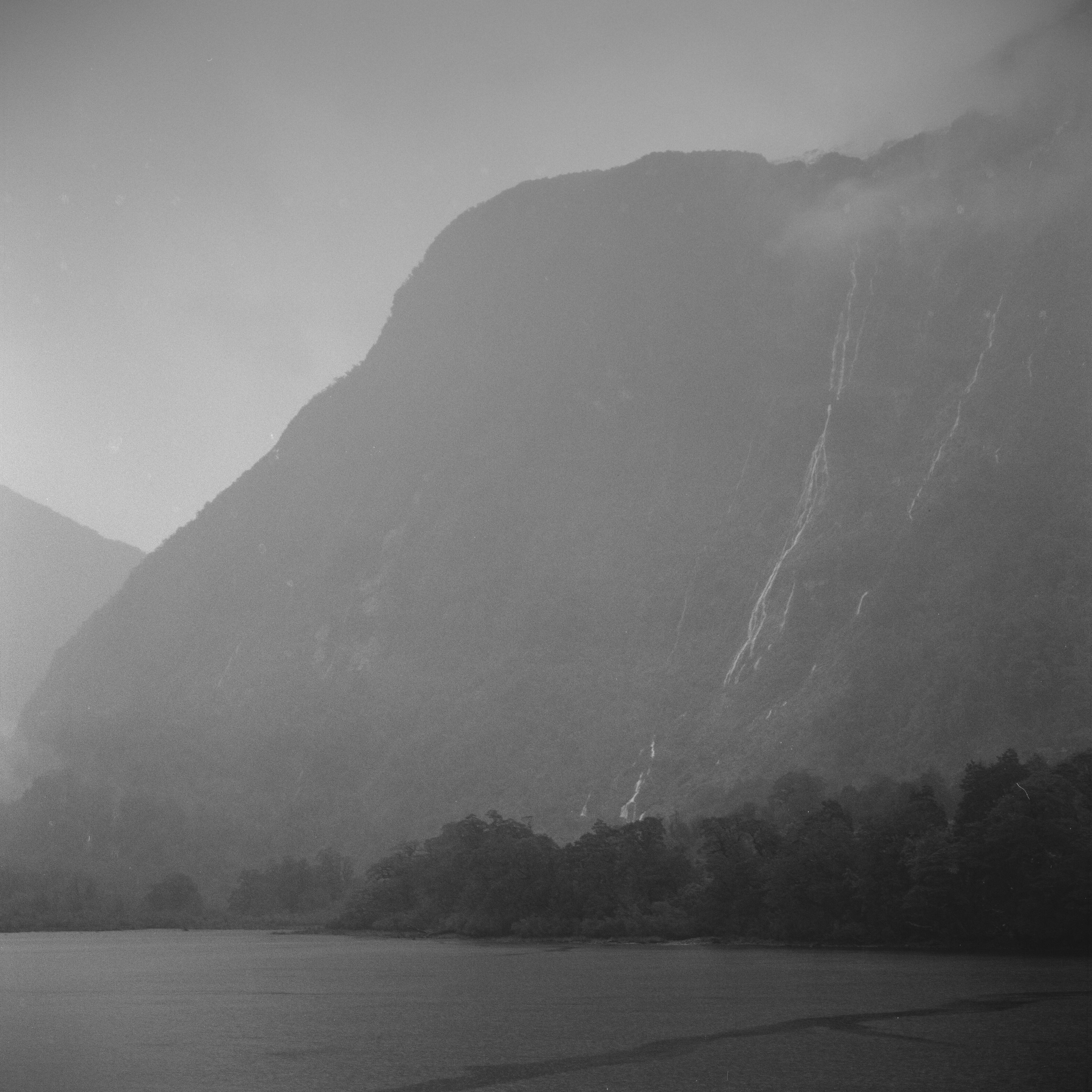
Doubtful Sound.
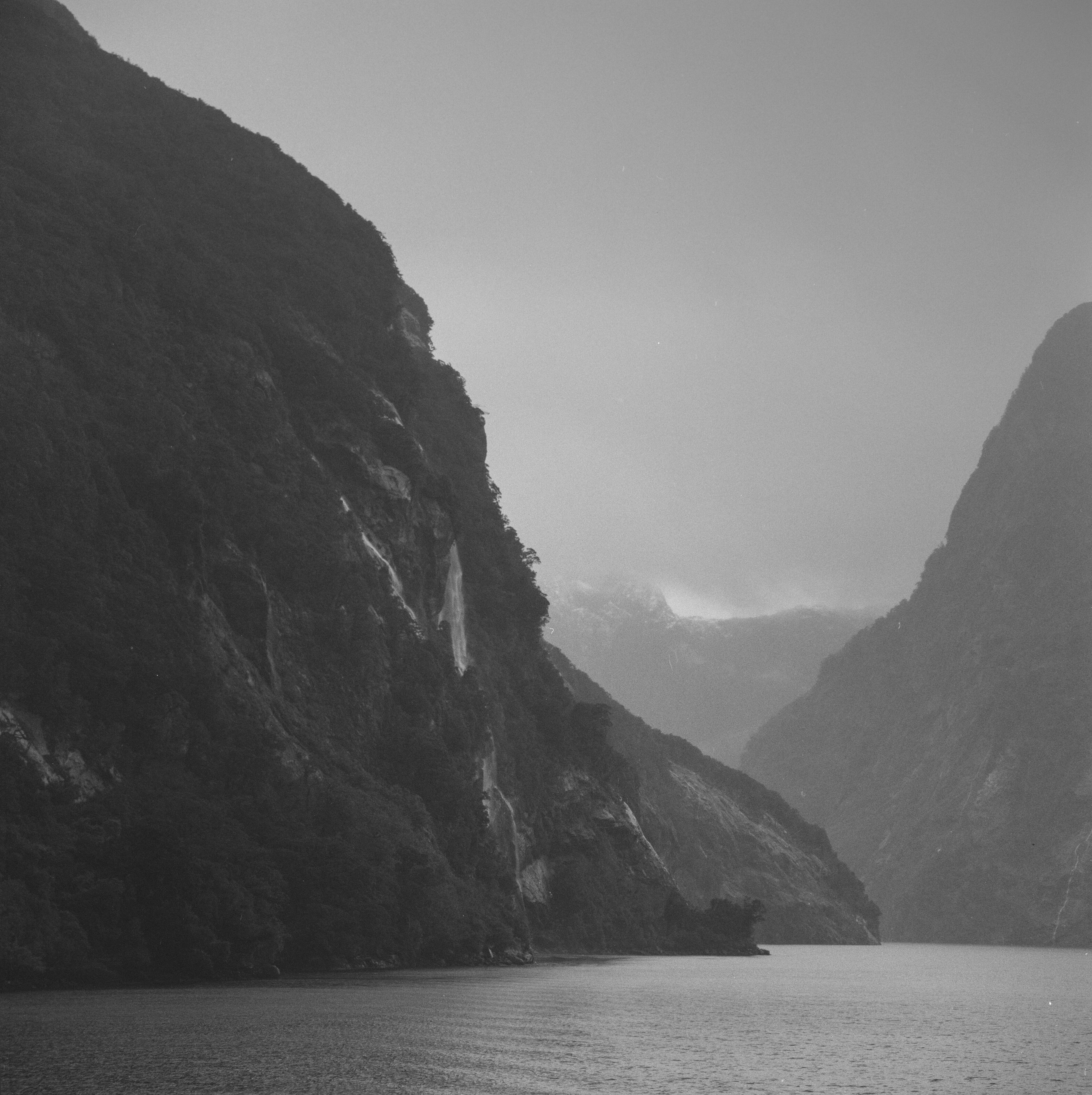
Doubtful Sound II.
We concluded the trip with a couple of days in the Queenstown area. The drive to Glenorchy was as stunning as ever although the Glenorchy township itself had changed since the last time I’d visited, receiving the promotion from tourist destination to tourist trap. The landscapes in the Wakatipu Basin cannot be criticised, and having beautiful walks such as Bob’s Cove and Mt Crichton Loop just fifteen minutes drive from the city is something that I’d kill for in Melbourne.
When revisiting these places across the South Island I could not help but evaluate whether I’d want to live there. Moving back to New Zealand some day seems like an inevitability, although there’s no sense of immediacy to do so. On previous trips living in the more populated areas such as Wanaka, Cromwell, and Queenstown attracted me. On this trip the more remote areas – Twizel, Omarama, Te Anau really stood out. They contrast the most with where I currently live, where escaping is the correct term to really get out of Melbourne city due to the time it takes to get anywhere.
We flew out of Queenstown over the Remarkables, a Titanic in a sea of familiarity.
